Field Report: New Yorks’ Adirondack Park is Having its Best Crossbill Year of the Century (So Far)
By Ryan F. Mandelbaum

Pull over on almost any conifer-lined road in the Central Adirondacks and listen for just a minute or two this winter. You’re almost guaranteed to hear a crossbill.
From January 28 to January 30, volunteers from the Finch Research Network surveyed portions of New York State’s Adirondack Park to document the conifer cone abundance and finch breeding activity. The trip revealed a bumper spruce crop and hundreds of finches singing and displaying, on top of other boreal specialties.
“In the 20+ years I’ve been doing crossbill work in NY state, this is the best overall crossbill year I’ve seen for both species at the same time,” said Matt Young in a recap of the trip.

The Adirondack Park consists of 6 million acres of public and private land protected by New York State. The Park features a mosaic of forest communities, including hardwood and mixed hardwood-conifer forests, spruce and balsam fir-dominated forests, and coniferous wetlands. The Adirondacks includes the southernmost examples of the boreal forest biome in eastern North America, and is thus home to birds which rarely or never breed elsewhere in New York State such as Canada Jays, Black-backed Woodpeckers, Boreal Chickadees, and White-winged Crossbills.
Easily-accessible stretches of contiguous boreal habitat occur in the center of the park around NY State Route 28N from the towns of Minerva to Long Lake, and around NY State Route 30 from Long Lake to Tupper Lake. These areas are popular with birders looking to spot boreal specialties without having to hike into the woods on frigid winter days. We spent approximately twelve hours surveying this region between January 28 and 29, 2022, and then finished our trip in the southwest Adirondack town of Piseco, where birders have reported large flocks of Red Crossbills this winter.
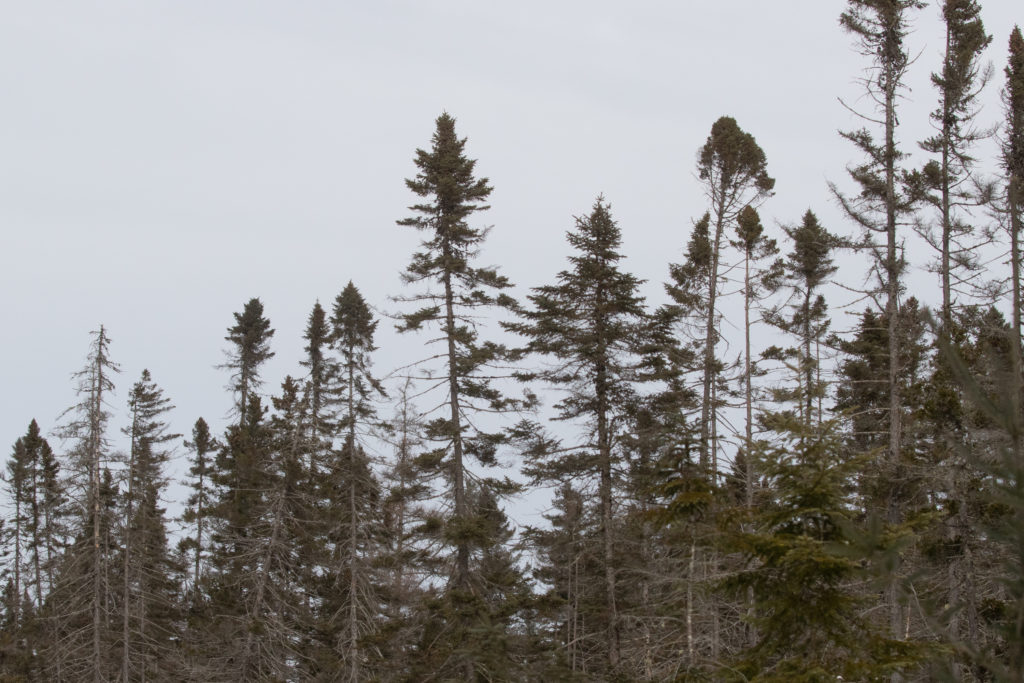
January 28, we began at dawn on Route 28N outside of Long Lake, stopping every few miles to listen for birds. Small groups of Purple Finches and Type 10 Red Crossbills called overhead. We headed to Tahawus Road, which once led to the now-abandoned mining town of Tahawus. This road features large stands of white spruce, a favorite small-coned food of White-winged Crossbills.
A Type 10 Red Crossbill sang for several minutes from a tall eastern white pine just a few hundred feet beyond the road’s start—a probable nest site. As we traveled north, we encountered small flocks of Type 10 Red Crossbills and Purple Finches—and then, a large mixed flock blocked our path. Two dozen Purple Finches fed on deciduous buds and balsam fir cones, with small numbers of Red Crossbills, Pine Siskins, and American Goldfinches cycling into and out of the flock. A few White-winged Crossbills called as they flew overhead and perched in the distance, as did a single Evening Grosbeak—six species of finches in just one spot.

On our way out, we came to a clearing of mixed spruces, pines, and cedars, and observed a small flock of Red and White-winged Crossbills, some of which were singing.
After lunch, we met up with Joan Collins in the Sabattis Bog area, a black spruce-tamarack bog surrounded by conifer and mixed hardwood-conifer forest and another popular spot for boreal bird seekers. A male-female pair of White-winged Crossbills waited for us, eating snow atop a telephone pole. Ultimately, we encountered 26 White-winged Crossbills and 17 Type 10 Red Crossbills in this area, with some individuals singing. We also encountered a pair of the bog’s friendly Canada Jays, plus a Ruffed Grouse feeding on buds in a treetop as we drove home.
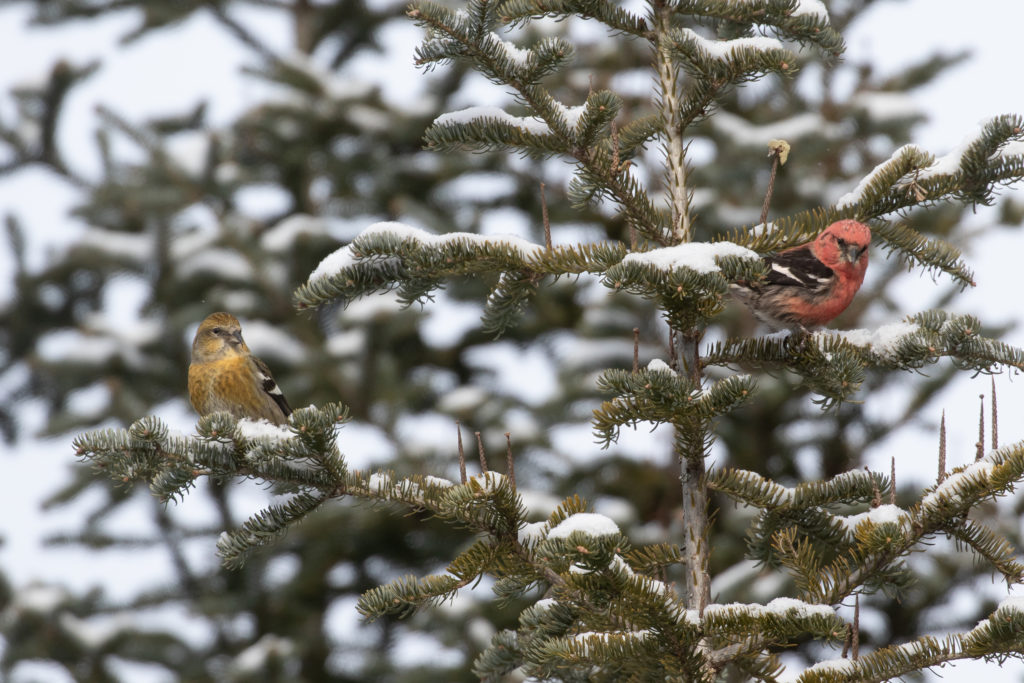
We headed out on January 29 joined by my spouse Brittany, and experienced an exceptional day of boreal birds. After stopping by Newcomb to photograph trees, we hurried to Blue Ridge Road, which cuts through another large tract of boreal forest and is a popular spot for observing Boreal Chickadees. We encountered single digits of Red Crossbills, White-winged Crossbills, Pine Siskins, and another Evening Grosbeak along the way to the prime stretch of boreal habitat. When we arrived, a dark figure circled the car—a first-year Golden Eagle. Expletives were uttered, and the bird stayed in view for several minutes before floating away.
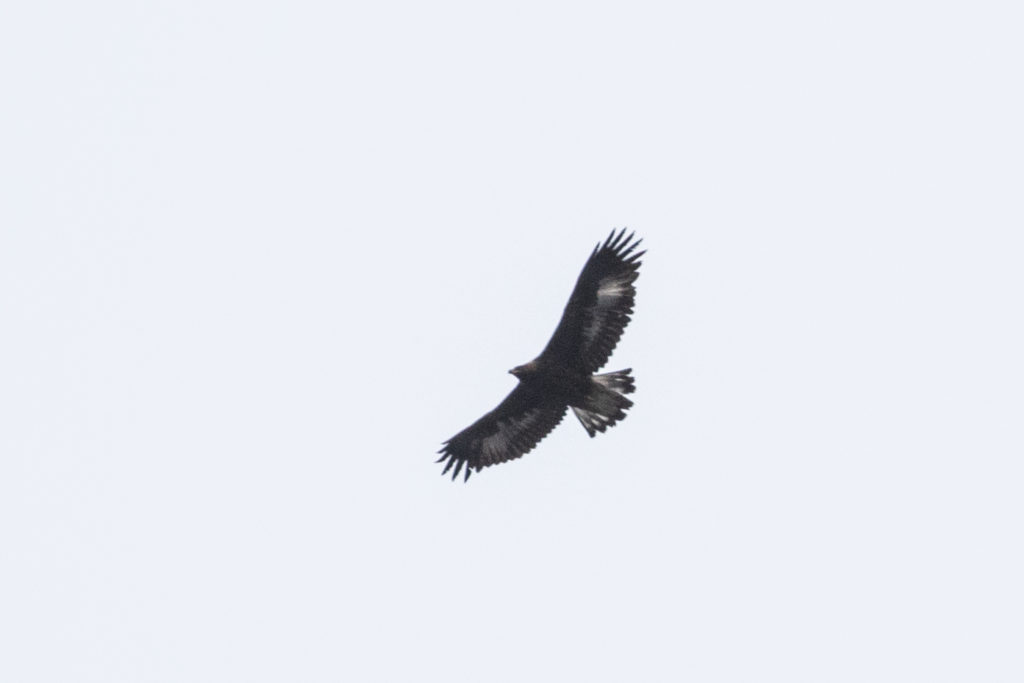
Continuing along the road, we encountered another pair of Canada Jays doing their best Northern Hawk Owl impressions, small flocks of Red and White-winged Crossbills, Purple Finches, and Pine Siskins, as well as plenty of Black-capped Chickadees and Red-breasted Nuthatches. At the end of the best habitat, we heard the nasally call of a Boreal Chickadee. Typical Blue Ridge Road Boreal Chickadee encounters feature a single individual skulking behind a Black-capped flock, but here we were treated to a pure flock of at least four birds calling from all around us. One bird fed in a tamarack out in the open for perhaps a minute before a Black-capped chased it off.
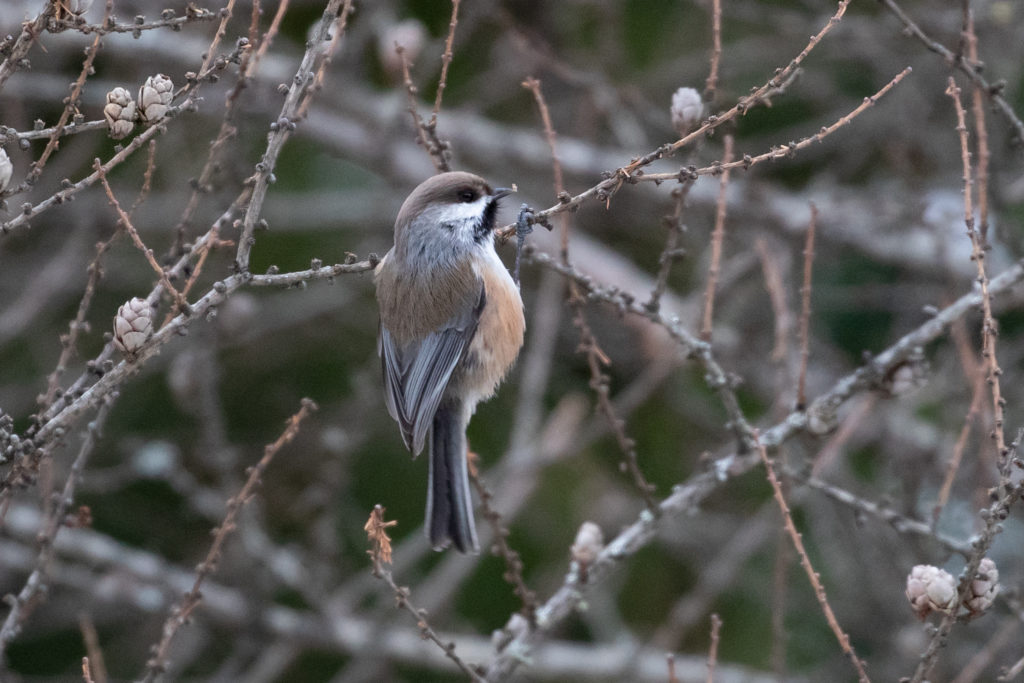
We returned to Tahawus Road on the way back, and it was even better than the day before. We stopped for several groups of crossbills gritting in the road, and then pulled over to listen for Black-backed Woodpeckers at a stand of dead spruces—we heard one “pik” with its fadeaway drumming in the distance. Before getting back into the car, we started to hear the trilling, frenetic songs of White-winged Crossbills and Pine Siskins further along the road at the same clearing we’d stopped by on the day before. We drove up and were treated to a boreal bonanza.
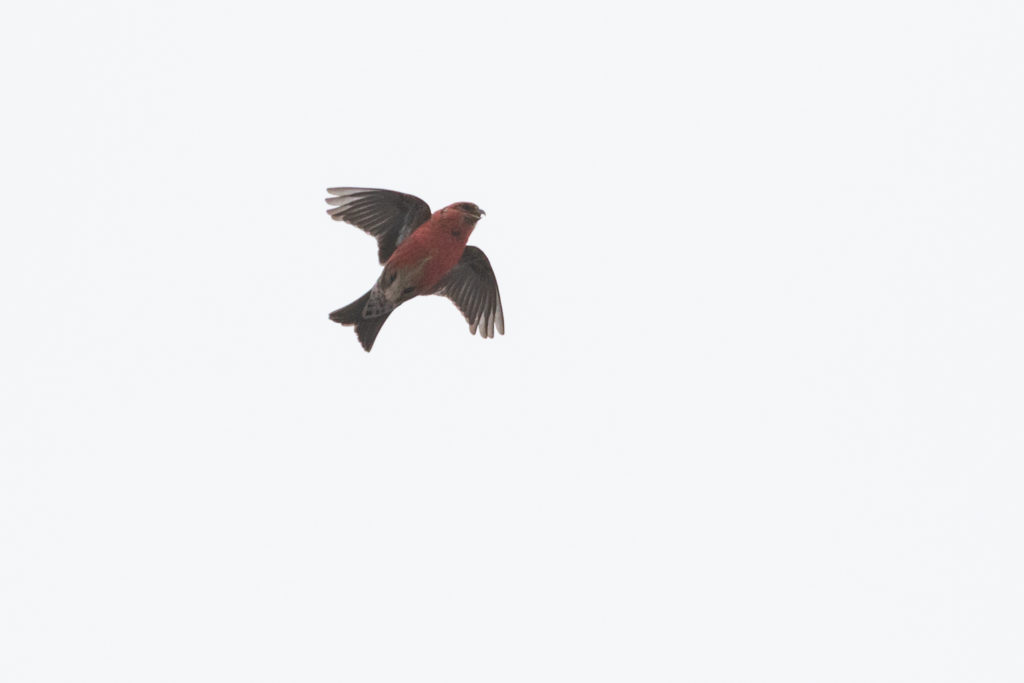
At least seven White-winged Crossbills were singing their metallic songs and performing song flight displays between treetops. A flock of Type 10 Red Crossbills mixed in and fed on white cedar cones, while a Pine Siskin sang further away. A series of gull-like calls rang over the din, and then an adult Northern Goshawk circled into view. The finches went unperturbed, and continued singing while a flock of American Goldfinches mixed into the madness.

Once things died down, we stopped for a few more crossbill flocks and then headed to Sabattis Bog once again—more to photograph trees than to see birds, though we did encounter four Canada Jays and several more crossbills of both species. At this point, the wind picked up and we were too cold to continue. We headed north to Tupper Lake for celebratory beer and pizza.
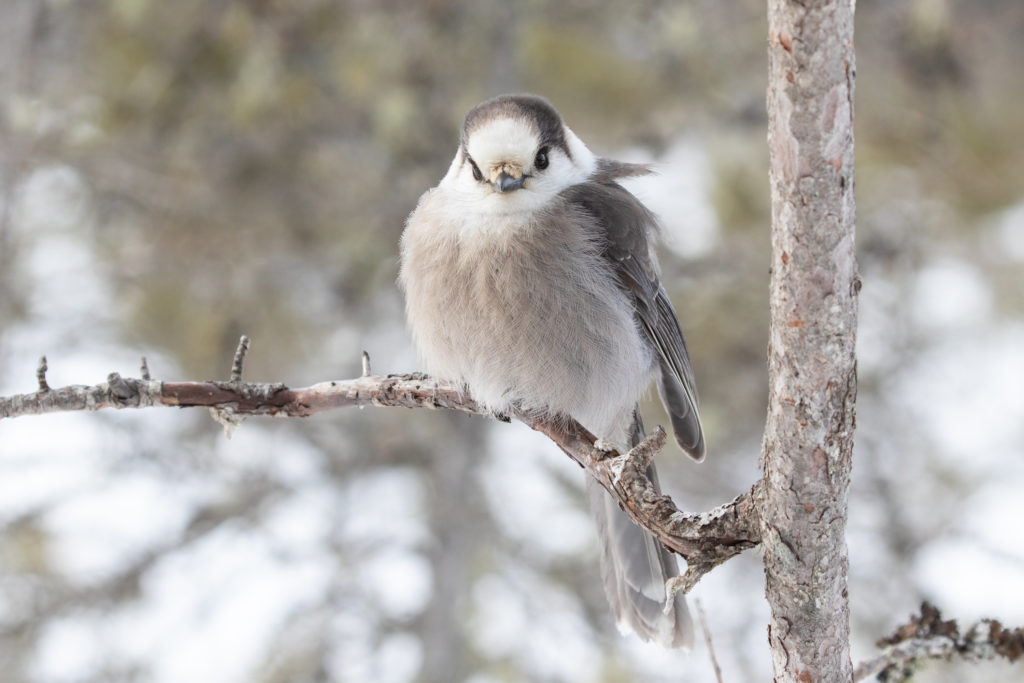
We began January 30th in a small patch of red spruce and balsam fir outside of Long Lake where Joan Collins’ group had reported a pair of Black-backed woodpeckers the day before. We didn’t see those birds, but we did come across more singing crossbills and flyover Pine Siskins. We didn’t linger long, as temperatures had dipped to -16 degrees Fahrenheit (that’s without the wind chill). We headed south to target Red Crossbills in the southern Adirondacks, since most of the birds in the Central Adirondacks had been too skittish to photograph and we’d heard about large numbers of birds congregating around the town of Piseco.
Red Crossbills gritted all along NY State Routes 30 and 8 leading from Long Lake to Piseco, roads less often birded but with lots of boreal habitat. Matt pulled over to observe a large flock of Pine Siskins outside of Speculator, counting 60 birds with a single Common Redpoll mixed in (and our seventh finch species for the trip). As soon as we turned off the highway onto Old Piseco Road, a small flock of docile Type 10 Red Crossbills and American Goldfinches gritted and posed for photos.
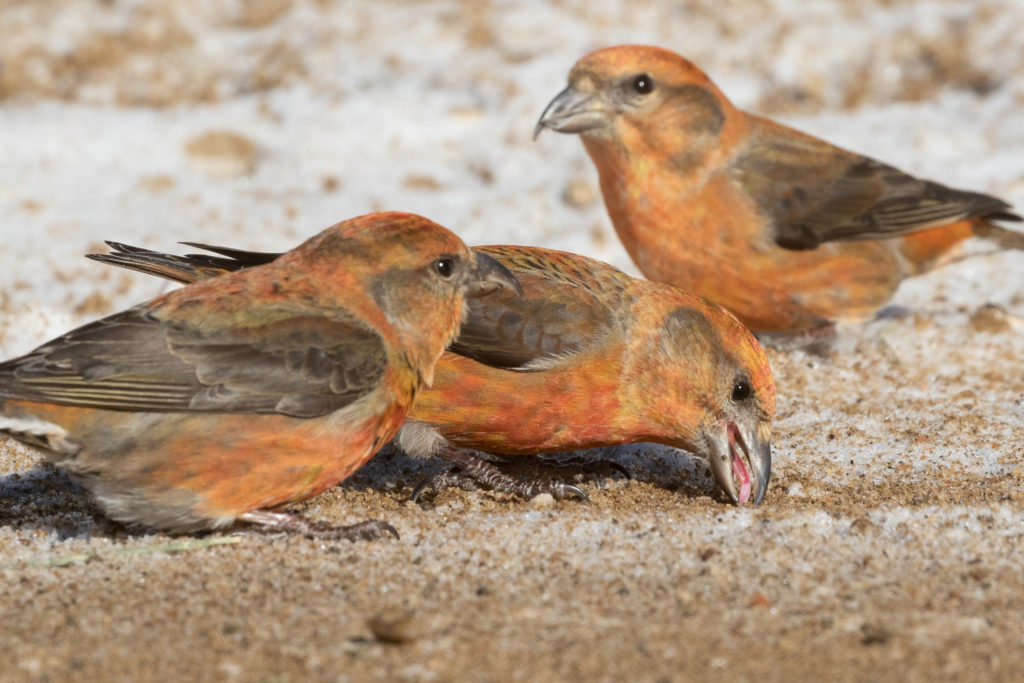
We located what seemed to be a Red Crossbill congregating spot further down the road by the Piseco Airport—a stand of deciduous trees on a private residence’s front lawn. Birds cycled in and out, singing, performing song flights, gritting, and feeding on the few cones in the area. Several Pine Siskins and American Goldfinches joined them. These flocks also allowed for close approach and photographs—one attempted to land on me, perhaps confusing my white coat for a snow pile. All of the Red Crossbills were type 10s.
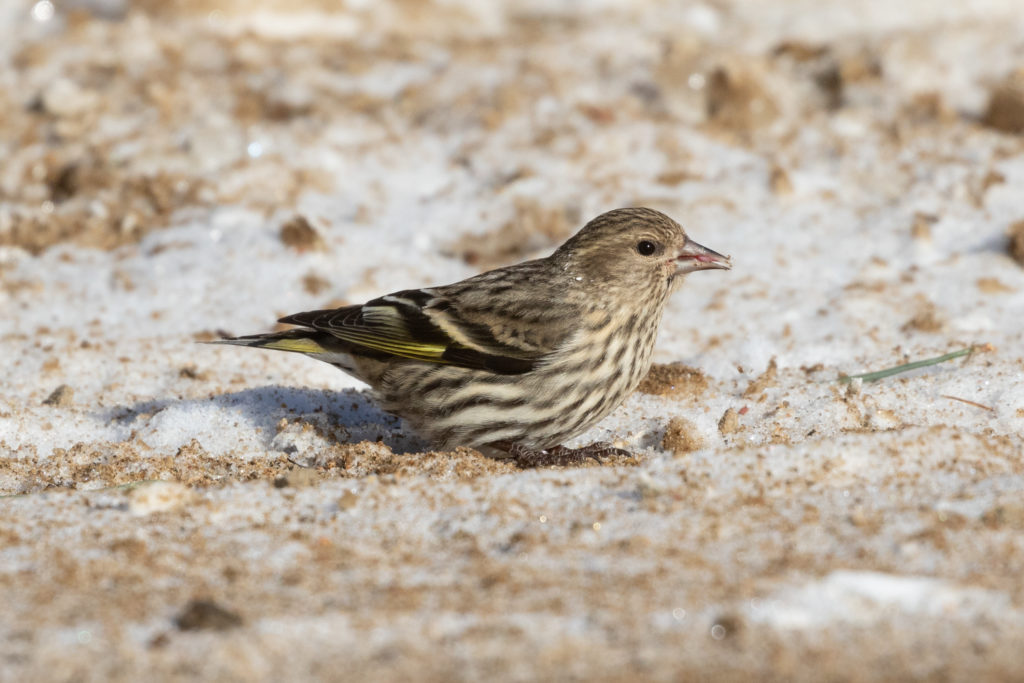
Once the crossbill flock dispersed, Brittany and I said our goodbyes and drove back to New York City. On the way home along Route 8, Matt also encountered more type 10 and a single type 1 Red Crossbill along with White-winged Crossbills (and Pine Siskins) nearly the whole way to the park’s southern border in the township of Morehouse.
All in all, the trip demonstrated that winter 2022 is a bumper year for both conifers and crossbills in the Adirondacks, with large numbers of both crossbill species. Red Crossbills seemed to outnumber White-winged Crossbills in all but the most boreal areas (those with large numbers of black and/or white spruce). Matt noted that, unlike other large Red Crossbill breeding events in the Adirondacks, this year features almost entirely type 10 birds, whereas other years typically include a smattering of type 1, 2 and 3 birds. Unless sudden weather changes cause the conifers cones to drop their seeds or become inaccessible, this winter and spring will be a prime opportunity to observe the breeding of both crossbills, as well as Pine Siskins, in the Adirondacks. 2020 to 2025 marks New York State’s third Breeding Bird Atlas, and birders should make the most of documenting breeding for these nomads during this time. Plenty of good conifer habitat exists south of the Adirondacks, too, such the state forests of Central New York and the northern Catskills.
You can see our eBird trip report linked here.
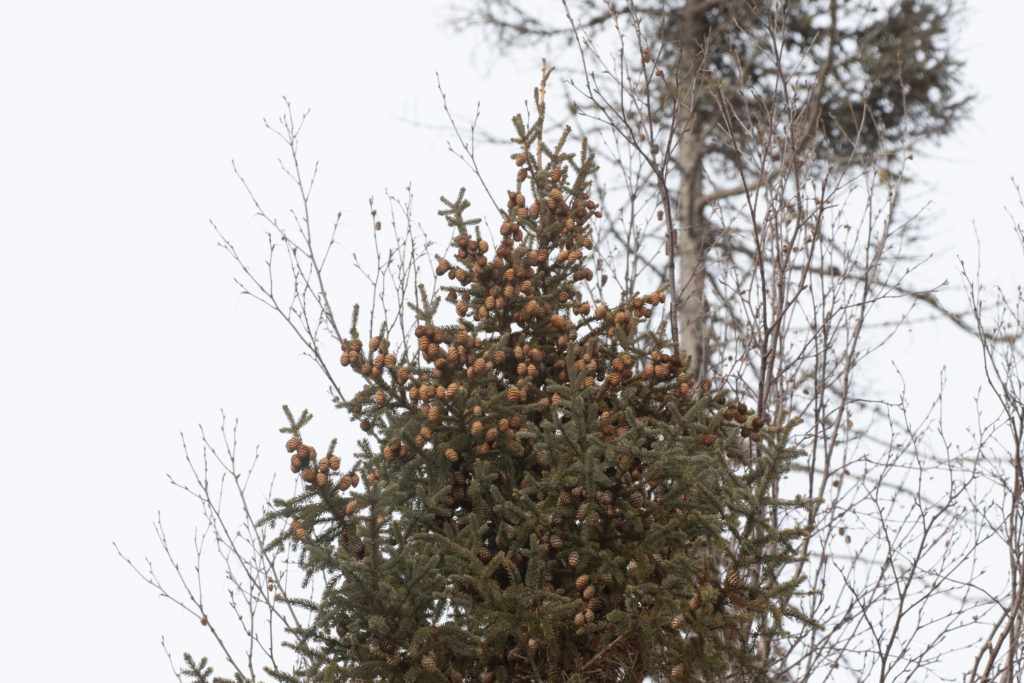
FiRN is a nonprofit, and has been granted 501c3 status. FiRN is committed to researching and protecting these birds and threatened finch species like the Evening Grosbeak, a species that has declined 92% since 1970. We are actively in the process of fundraising around an Evening Grosbeak Road to Recovery plan in addition to a student research project, so please think about supporting our efforts and making a small donation at the donate link below.
Tree recap: Crossbill favorite black, white, and red spruce crops are all good to bumper, as is Eastern Hemlock. We observed large numbers of cones on the few northern white cedars we encountered. We observed a moderate number of catkins on the alders, paper birch, and yellow birch trees. Red and Scotch pine crops were fair, and white pine crop poor.
Bird Totals:
2 Ruffed Grouse
12 Rock Pigeon
1 Golden Eagle
1 Sharp-shinned Hawk
1 Northern Goshawk
1 Red-tailed Hawk
1 Black-backed Woodpecker
3 Downy Woodpecker
9 Hairy Woodpecker
2 Pileated Woodpecker
6 Canada Jay
37 Blue Jay
5 American Crow
9 Common Raven
77 Black-capped Chickadee
4 Boreal Chickadee
2 Golden-crowned Kinglet
50 Red-breasted Nuthatch
2 White-breasted Nuthatch
3 Brown Creeper
1 American Robin
1 Cedar Waxwing
2 Evening Grosbeak
59 Purple Finch
1 Common Redpoll
192 Red Crossbill
109 White-winged Crossbill
98 Pine Siskin
126 American Goldfinch
1 Snow Bunting
5 Dark-eyed Junco
